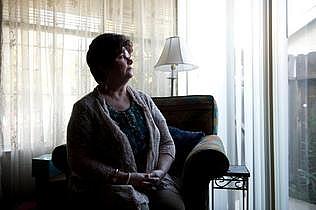Long search for children’s mental health data turns up treasure trove

Cindy Claflin is a family mental health advocate whose granddaughter has been taken to an emergency room twice in psychiatric crisis. PHOTO CREDIT: José Luis Villegas / Sacramento Bee
About a year ago, I started looking for a compelling story about children’s mental health in California. I knew I wanted something with policy ramifications. And I wanted it to be grounded in solid numbers.
In the world of mental health, concrete statistics can be surprisingly hard to find. Human stories abound, of course. Plenty of policies can use improvement. But data? That can be an oddly tough nut to crack.
I’d run into the same obstacle a few years earlier, while working on a series for The Modesto Bee on the sorry state of adult mental health services. My search for a statewide data set that would help paint a good picture of the issue stalled me for months on that story, before I finally decided to work around it.
This time, though, I felt determined to find some numbers. I’m no expert, but I know enough to realize that interesting data often leads to an interesting story.
Read Jocelyn Weiner's story in The Sacramento Bee
In my quest, I made lots of phone calls and had lots of meetings. Sources were sympathetic. They, too, would love to quantify the problems that existed with mental health services around the state. They, too, would like to be able to compare the situation of children in different counties. Perhaps, some suggested, the lack of data was a story in and of itself.
Maybe so. But it’d be a hard one to sell to my editor.
Then, one afternoon, I stumbled upon the website kidsdata.org, a treasure trove of data supported by the Lucile Packard Foundation for Children’s Health. One data point, on psychiatric hospitalizations, jumped out at me. According to kidsdata.org, the numbers had spiked in recent years.
With this new information, I put out more calls. Few people I spoke with seemed familiar with the phenomenon.
This intrigued me. Maybe, I thought, I was reading the data wrong. Maybe there had been some change in how information was being reported. Or maybe, really, this was a good story.
I contacted Phillip Reese, of The Sacramento Bee, and we submitted a request to the Office of Statewide Health Planning and Development.
The folks there were incredibly helpful. They sat down to talk with us and helped rule out any changes in data coding as explanations for the trend. They helped us fashion our initial requests and follow-up requests. They always got back to us in a timely manner.
In addition to requesting the overall numbers of hospitalizations for those 21 and under, we asked for them broken down by county, by payor source, by age and by ethnicity. The folks at OSHPD looked up readmission rates for us – any young person who had had a psychiatric hospitalization at least twice in a year. And when the 2012 data came out this fall, they updated it for us without complaint.
We also collected data on emergency room visits, suicide attempts, hospital bed shortages – and eventually we had a surprising set of numbers.
After that, of course, came the rest of the reporting – the search for explanations for the trend and the search for families who embodied it. The data was a jumping off point – and it proved a good place to start to report the story. We plan to keep at this story in the months to come.

